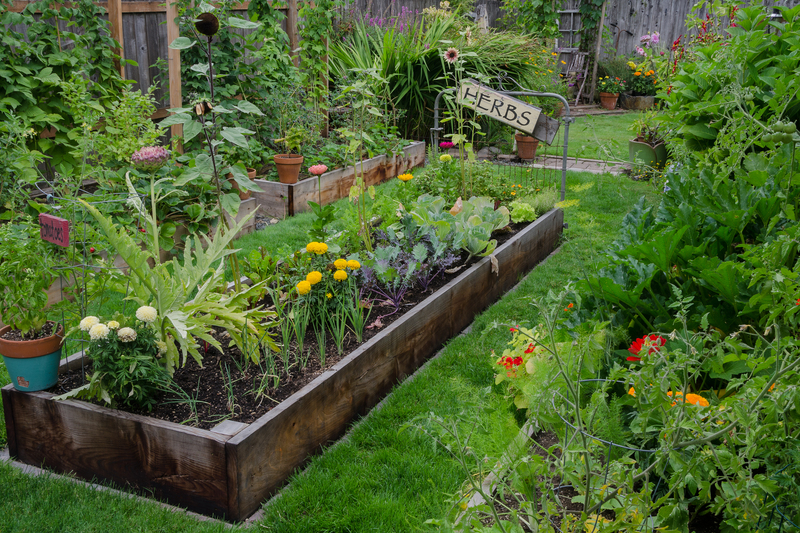Design Outdoor Spaces that Breathe Calm with Zen Garden Ideas
Posted on 21/09/2025
Design Outdoor Spaces that Breathe Calm with Zen Garden Ideas
Have you ever wondered how to turn your backyard, patio, or even a small balcony into a tranquil oasis that promotes peace, mindfulness, and relaxation? Designing outdoor spaces with Zen garden ideas can transform any area into a retreat that rejuvenates the mind and soothes the spirit. In this comprehensive guide, you'll discover everything you need to know about creating calm, inviting, and visually stunning Zen-inspired outdoor landscapes.

Introduction to Zen Gardens and Their Philosophy
Originating in Japan, Zen gardens—also known as Karesansui or dry landscape gardens—represent more than just a style of landscaping. They embrace a centuries-old philosophy centered around simplicity, balance, mindfulness, and harmony with nature. At their core, these gardens are meticulously designed to encourage quiet contemplation, meditation, and a profound sense of inner calm.
- Minimalism: Zen gardens use few elements to create visual impact.
- Symbolism: Every component, from rocks to moss, carries meaning.
- Asymmetry: Balance is achieved through natural, uneven arrangements.
- Tranquility: Promotes relaxation through subtle design.
Whether you have a sprawling yard or a tiny urban space, infusing Zen garden concepts can help you create an environment that is both beautiful and deeply soothing.
Main Elements of a Calming Zen Outdoor Space
When planning your tranquil space, it's helpful to understand the main elements that define Zen-inspired gardens. Each feature holds symbolic significance in Japanese culture and plays a role in fostering a meditative ambiance.
Rocks and Stones
Stones form the backbone of any Zen garden. Large stones represent mountains or islands, while smaller ones can symbolize animals or foothills. Try arranging stones in natural groupings to mimic organic landscapes.
- Tip: Avoid symmetrical placements; asymmetry fosters a natural flow.
- Bonus: Flat pebbles work well for small patios.
Gravel or Sand
Fine gravel or sand replaces water in traditional Zen designs. Raked into patterned lines and swirls, it symbolizes rivers, oceans, or the flow of energy. Not only does it add texture, but the ritual of raking itself is a calming, mindful practice.
- Consider: White gravel for brightness, or tan/brown for warmth.
- Maintenance: Rake regularly to keep patterns fresh and tidy.
Moss and Greenery
Though foliage is used sparingly, moss and other low-maintenance ground covers add a lush pop of green against the sand or stone. Bamboo, ferns, dwarf pines, or ornamental grasses all fit beautifully into the Zen aesthetic.
- Choose: Moss for shady areas; it softens hard features and holds moisture.
- Avoid: Flowerbeds and bright blooms; keep it subtle with varying shades of green.
Water Features
While not always present, water features such as small ponds, fountains, or a cascading bamboo spout can add a soothing auditory element. The sound of flowing water amplifies the peaceful vibe and adds movement to the garden.
- Benefits: Masks urban noise, encourages wildlife, and cools the air.
Paths and Stepping Stones
Curving pathways create a journey through your outdoor Zen space, inviting slow, mindful walking. Use natural stone slabs, gravel, or wood to guide the way. Paths shouldn't be straight or overly formal—embrace gentle curves and organic layouts.
- Tip: Space stepping stones unevenly for a more authentic look.
Simple Ornaments and Structures
A stone lantern, a bamboo gate, or a minimalist bench can serve as subtle focal points. Choose pieces that blend in rather than dominate, supporting the overall harmony without adding clutter.
Zen Garden Ideas for Different Outdoor Spaces
Now, let's explore how you can adapt Zen garden principles to suit a variety of outdoor settings:
Backyards and Large Gardens
If you have a spacious garden, consider creating multiple zones: a rockery area, a raked gravel patch, a small koi pond, and a shaded meditation nook surrounded by bamboo. Layer elements so each feature flows into the next, guiding visitors through a peaceful journey.
- Add a weathered wood bench for contemplation.
- Plant pine and Japanese maple for year-round interest.
- Install a simple bridge over a dry stream bed.
Patios and Decks
Outdoor patios are ideal for small-scale Zen garden designs. Place a large basin filled with stones and sand as a centerpiece. Create a mini moss garden in pots, and add solar-powered lanterns for evening ambiance.
- Hang bamboo wind chimes for gentle soundscape.
- Line up potted ferns along the edge for privacy.
Balconies and Urban Spaces
Limited space? No problem. Tabletop Zen gardens are perfect for city living. Use a shallow tray with sand, a few smooth river rocks, and a tiny rake for daily meditation practices right outside your door.
- Use vertical planters for moss or bamboo to save floor space.
- Incorporate a compact tabletop fountain for tranquil sounds.
Step-by-Step Guide to Creating Your Zen Garden
Ready to bring Zen bliss to your own backyard or balcony? Follow these steps to design an outdoor area that breathes calm and nurtures tranquility.
- Choose Your Location:
- Pick a spot with partial sun and shade.
- Consider views from indoors for maximum enjoyment.
- Clear and Prepare the Area:
- Remove debris, weeds, and grass for a clean slate.
- Plan Your Layout:
- Sketch out where rocks, sand, plants, paths, and accents will go. Aim for asymmetry.
- Leave open space for visual breathing room.
- Add Hardscapes:
- Place large rocks first to ground the design.
- Add stepping stones or a gravel path.
- Incorporate Ground Cover:
- Spread sand or gravel and smooth it out with a rake.
- Pattern the surface with gentle lines or spirals.
- Introduce Plants:
- Select low-maintenance, shade-loving greenery like moss or ferns.
- Arrange in small groups for subtle color and texture.
- Install Water Features and Accessories:
- Add a simple fountain or stone basin for movement and sound.
- Place lanterns or benches for restful accents.
- Enjoy and Maintain:
- Rake gravel regularly for meditation and mindfulness.
- Prune plants to maintain clean lines and shapes.
Additional Tips for a Zen-Inspired Outdoor Retreat
- Keep Clutter to a Minimum: Simplicity is key. Avoid overloading the space with decorations or plants.
- Engage the Senses: Think about how your garden will sound, look, and even smell. Bamboo and moss absorb sound, water features add auditory calm, and pine needles release subtle scents.
- Work With the Seasons: Select evergreens for year-round color. Deciduous trees like Japanese maple offer vivid hues in autumn.
- Choose Sustainable Materials: Use natural stone, reclaimed wood, and drought-resistant plants for eco-friendly design.
- Personalize Your Space: Add a meditation cushion, a favorite statue, or hand-built stone stacks for a unique touch.
Zen Garden Maintenance for Lasting Tranquility
To preserve your outdoor Zen garden’s calming ambiance, regular but gentle maintenance is a must. Here's how to keep your oasis looking and feeling serene:
- Rake gravel or sand in new patterns weekly to refresh energy and dispel stagnant chi.
- Remove fallen leaves and debris promptly to maintain visual purity.
- Prune shrubs and trees carefully—aim for natural, elegant shapes, not overly manicured forms.
- Keep water features clean to prevent algae buildup and ensure clear, tranquil sounds.
- Replace or reposition stones occasionally to renew the garden's sense of discovery and novelty.
*Remember: Caretaking itself is part of the mindful Zen experience!*
Health and Wellness Benefits of Zen Outdoor Spaces
- Stress Reduction: The calm environment and rhythmic patterns relax the mind and lower cortisol.
- Enhanced Mindfulness: Time spent raking, pruning, and appreciating subtle details promotes presence and awareness.
- Connection with Nature: Even small Zen gardens foster a sense of unity with the seasons and the living world.
- Mental Clarity and Focus: Surrounded by serenity, creativity and solution-finding become easier.
- Social Harmony: Zen spaces are ideal for sharing quiet moments or gentle conversation with loved ones.
Simple Zen Garden Ideas for Every Budget
Creating an *outdoor Zen sanctuary* doesn't have to be expensive. Here are budget-friendly Zen garden tips:
- Repurpose natural materials found locally, such as river rocks, driftwood, or fallen branches.
- Buy plants in small containers and let them grow slowly for a more authentic effect.
- Build your own raking tools or benches from reclaimed wood.
- Look for decorative items at flea markets and thrift stores.
- Start with a small area and expand as time and budget permit.

Frequently Asked Questions on Designing Zen Gardens
How much space do you need for a Zen garden?
Zen gardens can be as large as a full backyard or as small as a tabletop tray. The philosophy adapts for any size.
Can I incorporate seating into a Zen garden?
*Absolutely!* Add a stone bench or a cushion on a weather-proof mat for meditation and contemplation.
What are the best plants for a Zen-inspired outdoor space?
Choose low-maintenance, muted plants: moss, ferns, Japanese maple, bamboo, dwarf conifers, and ornamental grasses.
Do Zen gardens require a lot of maintenance?
They are generally low-maintenance. Occasional raking, pruning, and cleaning keep everything serene.
Is it okay to add flowers?
Traditionally, Zen gardens avoid bright blooms. Subtle, seasonal touches like cherry blossoms can be used sparingly.
Conclusion: Transform Your Outdoor Space with Zen Garden Ideas
Whether you're seeking an escape from the bustle of city life or simply want to create a tranquil outdoor retreat, embracing Zen garden design principles can breathe calm into any space. By combining natural materials, thoughtful layout, and mindful care, you can craft a lush haven that delights the senses and nurtures the soul. Whatever your landscape, size, or budget, let these Zen garden ideas inspire you to unlock the power of peace, presence, and enduring beauty in your outdoor sanctuary.
Ready to design your own Zen-influenced paradise? Begin with a single stone, a patch of moss, or a simple path, and let tranquility grow from there.

